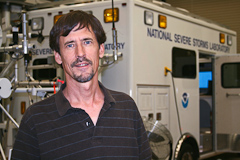This article's use of external links may not follow Wikipedia's policies or guidelines.(October 2021) |
Erik Rasmussen | |
|---|---|
 | |
| Born | January 27, 1957 |
| Alma mater | University of Oklahoma (B.S., 1980) Texas Tech University (M.S., 1982) Colorado State University (Ph.D., 1992) [1] |
| Known for | Supercell and tornadogenesis research, field project leadership |
| Awards | Presidential Early Career Award for Scientists and Engineers [2] |
| Scientific career | |
| Fields | Meteorology |
| Institutions | NSSL, CIMMS, Rasmussen Systems |
| Thesis | Observational and Theoretical Study of Squall Line Evolution (1992) |
| Doctoral advisor | Steve Rutledge [1] |
Erik Nels Rasmussen (born January 27, 1957) is an American meteorologist and leading expert on mesoscale meteorology, severe convective storms, forecasting of storms, and tornadogenesis. He was the field coordinator of the first of the VORTEX projects in 1994-1995 and a lead principal investigator for VORTEX2 from 2009 to 2010 [3] and VORTEX-SE from 2016 to 2017, [4] as well as involved in other smaller VORTEX offshoots and many field projects.